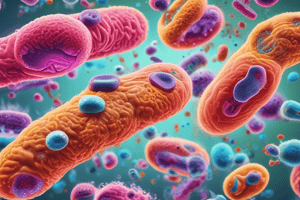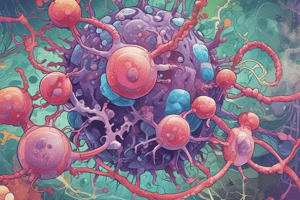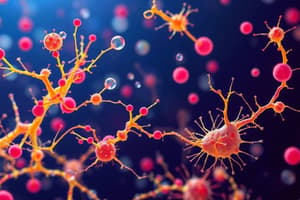Podcast
Questions and Answers
Which characteristic distinguishes bacteria as prokaryotic microorganisms?
Which characteristic distinguishes bacteria as prokaryotic microorganisms?
- Complex chemical composition of DNA
- Ability to perform true sexual reproduction
- Presence of a nuclear membrane
- Lack of a true nucleus (correct)
What is the primary component of bacterial cell walls?
What is the primary component of bacterial cell walls?
- Silica
- Chitin
- Cellulose
- Peptidoglycan (correct)
How does the large surface area to volume ratio benefit bacteria in nutrient-poor environments?
How does the large surface area to volume ratio benefit bacteria in nutrient-poor environments?
- It facilitates faster movement.
- It reduces the need for water.
- It enhances the efficiency of nutrient uptake. (correct)
- It increases the rate of photosynthesis.
What process do bacteria primarily use to reproduce?
What process do bacteria primarily use to reproduce?
Through what processes can genetic recombination occur in bacteria, despite the lack of true sexual reproduction?
Through what processes can genetic recombination occur in bacteria, despite the lack of true sexual reproduction?
What is the role of mesosomes in bacteria?
What is the role of mesosomes in bacteria?
How does the diversity in bacterial shapes contribute to their survival?
How does the diversity in bacterial shapes contribute to their survival?
Cocci arranged in irregular clusters are referred to as what?
Cocci arranged in irregular clusters are referred to as what?
What term describes bacteria that lack flagella?
What term describes bacteria that lack flagella?
What is the main function of flagella in bacteria?
What is the main function of flagella in bacteria?
What is the function of the bacterial capsule?
What is the function of the bacterial capsule?
What is the main difference between Gram-positive and Gram-negative bacteria regarding their cell walls?
What is the main difference between Gram-positive and Gram-negative bacteria regarding their cell walls?
Which component is unique to Gram-positive bacteria cell walls?
Which component is unique to Gram-positive bacteria cell walls?
What is the sedimentation rate of bacterial ribosomes?
What is the sedimentation rate of bacterial ribosomes?
What are the nutritional types of bacterial metabolism mentioned?
What are the nutritional types of bacterial metabolism mentioned?
Which phylum includes the bacteria informally known as the 'purple bacteria and their relatives'?
Which phylum includes the bacteria informally known as the 'purple bacteria and their relatives'?
Which phylum consists of bacteria that are obligate intracellular pathogens and infect eukaryotic host cells?
Which phylum consists of bacteria that are obligate intracellular pathogens and infect eukaryotic host cells?
Which of the following describes the ecological role of some bacteria in the context of soil fertility?
Which of the following describes the ecological role of some bacteria in the context of soil fertility?
In the context of industrial applications, what role does Acetobacter aceti play?
In the context of industrial applications, what role does Acetobacter aceti play?
What is the key difference between viruses and bacteria according to the text?
What is the key difference between viruses and bacteria according to the text?
Flashcards
Bacteria
Bacteria
Simplest prokaryotic microorganisms with DNA, RNA, and protein. They are highly adaptable and found in diverse environments.
Bacteriology
Bacteriology
Branch of microbiology studying bacteria, focusing on their role in causing diseases.
Bacterial Cell Characteristics
Bacterial Cell Characteristics
Single-celled, lack organelles like chloroplasts and mitochondria, and possess a nucleoid with circular DNA.
Bacterial Reproduction
Bacterial Reproduction
Signup and view all the flashcards
Bacterial Shapes
Bacterial Shapes
Signup and view all the flashcards
Staphylococcus/Micrococcus
Staphylococcus/Micrococcus
Signup and view all the flashcards
Monotrichous
Monotrichous
Signup and view all the flashcards
Flagellum
Flagellum
Signup and view all the flashcards
Fimbriae
Fimbriae
Signup and view all the flashcards
Pili
Pili
Signup and view all the flashcards
Slime Layer
Slime Layer
Signup and view all the flashcards
Capsule
Capsule
Signup and view all the flashcards
Cell Wall
Cell Wall
Signup and view all the flashcards
Gram Staining
Gram Staining
Signup and view all the flashcards
Plasma Membrane
Plasma Membrane
Signup and view all the flashcards
Cytoplasm
Cytoplasm
Signup and view all the flashcards
Inclusions
Inclusions
Signup and view all the flashcards
Metabolism (Bacteria)
Metabolism (Bacteria)
Signup and view all the flashcards
Economic Importance of Bacteria
Economic Importance of Bacteria
Signup and view all the flashcards
Bacteria vs. Viruses
Bacteria vs. Viruses
Signup and view all the flashcards
Study Notes
Bacteria Overview
- Simplest prokaryotic microorganisms.
- Composed of DNA, RNA, and protein.
- Among the first living organisms on Earth.
- Found in diverse environments, including soil, water, hot springs, radioactive waste, and deep portions of the earth's crust
- Can thrive in symbiotic and parasitic relationships with plants and animals.
- Have flourished in manned spacecraft
- Adaptable to temperature, pH, oxygen, and pressure extremes.
- Have an estimated biomass of 5 x 10^30 on Earth.
- Biomass exceeds all plants and animals.
- Antonie Van Leeuwenhoek discovered bacteria in 1676.
- Used a single-lens microscope of his own design.
- Christian Gottfried Ehrenberg introduced the term "bacterium" in 1828.
- Pasteur established bacteriology, highlighting the importance of bacteria as pathogens.
- Bacterial cell lengths typically range from 0.5 to 5.0 μm.
- Over 2,000 species exist and belong to the kingdom Monera.
Characteristics of Bacteria
- Single-celled organisms lacking organelles like chloroplasts and mitochondria
- Lack a true nucleus, are prokaryotic
- Possess double-stranded, continuous, and circular DNA in a nucleoid, without a nuclear membrane
- Have a cell membrane and a peptidoglycan cell wall
- Possess a large surface area to volume ratio that allows them to thrive in nutrient-poor environments
- Grow in numbers through binary fission, not in size
- Can exist as single cells or in clusters.
- Exhibit heterotrophic (parasitic or saprophytic) or autotrophic lifestyles
- Reproduce by binary fission after reaching a specific size
- Lack true sexual reproduction.
- Undergo genetic recombination via conjugation, transformation, and transduction.
- Their plasma membrane invaginates to form mesosomes.
- Do not experience natural death
Bacterial Shapes
- Exhibit various shapes, including spheres, rods, and spirals.
- Shape influences nutrient acquisition, surface attachment, movement, and predator avoidance.
- Most bacterial species are spherical (cocci) or rod-shaped (bacilli).
- Some are curved rods (vibrio).
- Others are spiral-shaped (spirilla or spirochetes).
- Some possess tetrahedral or cuboidal shapes (Arcula sp).
- Some elongate into filaments.
- Some alter their shape based on environmental conditions (e.g., Deinococcus sp., Helicobacter pylori, Mycosplasma sp).
- Cocci can form Staphylococcus/Micrococcus (irregular clusters), Diplococcus (pairs), Streptococcus (chains), Sarcina (cubical packets of 8), or Tetrad (groups of 4).
Motility
- Can be motile or non-motile, moving via gliding.
- Motile bacteria have flagella, which are whip-like structures arising from one or both ends or all over the cell
- Bacteria lacking flagella are termed atrichous.
- Flagellar arrangements include monotrichous (single polar flagellum, e.g., Xanthomonas sp.), lophotrichous (multiple flagella at one or both ends, e.g., Pseudomonas fluorescens), peritrichous (flagella over the entire surface, e.g., Escherichia coli), and amphitrichous (flagella at both ends, e.g., Alcaligenes faecalis).
Bacterial Cell Structure
- Typical cells have surface appendages, surface adherents, a cell wall, a plasma membrane, and cytoplasm
- Surface appendages include flagella, fimbriae, and pili.
- Flagella are rigid structures (20 nm diameter, up to 20 µm length) used for motility.
- Flagella are composed of flagellin.
- Consist of a basal body, hook, and filament.
- The hook connects the filament to the basal body's motor portion.
- Basal bodies are anchored in the cytoplasmic membrane and cell wall, using energy from ion transfer across the cell membrane,
- Fimbriae are protein filaments (2-10 nm diameter, up to several μm length) that are shorter and stiffer than flagella.
- Distributed on the cell wall surface, resembling fine hairs under an electron microscope
- Have adhesins for host tissue identification.
- Help bacteria attach to substrates and contribute to the virulence of pathogenic bacteria.
- Pili are tube-like projections on the cell wall surface, similar to fimbriae but larger
- Specialized pili (sex pili) transfer plasmid DNA during conjugation and can generate movement.
- Surface Adherents or Glycocalyx: Include the slime layer and capsule
- Vary structurally and protect against engulfment by eukaryotic cells.
- Act as antigens and aid in cell recognition and surface attachment; can also serve as a storage product
- Slime Layer: A disorganized, non-fluid extracellular polymer that is loosely associated with the bacterium, protecting against environmental threats like antibiotics and desiccation.
- Capsules: The outermost bacterial cell layer, made of polysaccharides, disaccharides, or polypeptides, tightly attached with defined boundaries.
- Cell Wall: Made of peptidoglycan, comprising 20% of the cell's dry weight
- Cell Wall: Gives shape, firmness, and resistance to mechanical/chemical injuries, including lysozyme. Can be thick (Gram-positive) or thin (Gram-negative).
Gram Staining
- Gram staining distinguishes bacteria based on cell wall composition
- Gram-positive bacteria retain the stain after alcohol treatment
- Gram-negative bacteria do not.
- Gram staining technique developed by Hans Christian Gram in 1884 involves applying a bacterial suspension to a glass slide, fixing it with gentle heating, and successively dipping it in crystal violet and dilute iodine solutions.
- The preparation is treated with alcohol or acetone for decolorization.
- Gram-positive bacteria retain the stain's color, while gram-negative bacteria become decolorized.
- Counterstaining with safranin or carbol-fuschin turns Gram-negative bacteria red and Gram-positive bacteria deep purple.
Composition
- Gram-positive bacteria have a homologous cell wall layer; Gram-negative have 3 layers.
- Gram-positive walls consist of 85% mucopeptide, while Gram-negative walls contain 88-99% lipoprotein/lipopolysaccharides
- Gram-positive bacteria have teichoic acid, which is absent in Gram-negative bacteria
- Gram-positive bacteria are much-rigid, while Gram-negative bacteria are less-rigid
- Gram-positive cell walls are thicker with only traces of lipids while Gram-negative walls are thinner and may contain up to 20% lipids
- Gram-positive cell walls do not contain all the amino acids, but Gram-negative bacteria do
- Gram-positive bacteria have muramic acid plenty while Gram-negative have less.
Cell and Plasma Membrane
- Composed of lipids.
- Encloses cell contents, serving as a barrier for nutrients and components.
- Involved in biosynthetic pathways, nutrient transport via enzyme permeases, electron transport and oxidative phosphorylation in aerobic bacteria, light-gathering complexes in photosynthetic bacteria, chemotaxis, and attachment sites for chromosomal/plasmid DNA.
Cytoplasm
- Lacks membrane-bound organelles; contains nucleoid, cytoskeleton, ribosomes, chromtophores, volutine/metachromatic granules, gas vacuoles/vesicles, carboxysomes, inclusions, magnetosomes, and plasmids.
- Carboxysomes are micro-compartments to controls bacterial metabolism, containing carbon fixation enzymes.
- The nucleoid contains genetic material, including proteins and RNA.
- Ribosomes, grouped in chains called polyribosomes produce proteins.
- Ribosomal sedimentation rate is 70S.
- Subunits are 30S and 50S.
- Chromatophores facilitate photosynthesis using bacterio-chlorophyll pigments and carotenoids.
- Inclusions are non-living made of glycogen, polyphosphate, sulfur or polyhydroxyalkanoates, lipid droplets, crystals and pigments which are granules for nutrient storage.
- Gas vesicles and vacuoles regulate the buoyancy of the bacterial cells in water.
- Volutin or metachromatic granules are cytoplasmic inclusions of complex inorganic phosphate and show metachromatic effects.
- Magnetosomes are compartments containing magnetic crystals.
- Mesosomes are involved in cell wall synthesis, secretion of extracellular substances, genome replication, and cell division.
- Plasmids are non-essential DNA pieces that act as nucleoids.
Physiological Processes
- Bacteria exhibit metabolic diversity using small molecules that enter the cell via diffusion or channels
- Nutritional types include phototrophs (sunlight), lithotrophs (inorganic compounds), and organotrophs (organic compounds).
- Asexual reproduction occurs through binary fission or budding.
- Growth is affected by temperature (0-85°C), pressure, moisture, and pH (5-9).
Classification and Diversity
- Diversity among bacteria is categorized by structure, metabolism, cell components, and Gram staining.
- Modern classification utilizes guanine-cytosine ratios, genome hybridization & rRNA sequencing.
- Major bacterial groups include Proteobacteria (Gram-negative bacteria belonging to genera like Escherichia/Salmonella), Actinobacteria (Gram-positive bacteria belonging to genera like Mycobacterium), Firmicutes (Gram-positive bacteria belonging to genera like Megasphaera), Cyanobacteria (blue-green algae like Chroococcales), Chlamydales (obligate intracellular pathogens that infect eukaryotic host cells like Chlamydia trachomatis), Planctomycetes (aquatic bacteria like Kolteria novifilia), Verrucomicrobia (bacteria isolated from water, soil and human feces like Verrucomicrobium spinosum), Acidobacteria (acidophilic bacteria such as Acidobacterium capsulatum), Cytophaga (gram-negative, rods using locomotion such as Cytophaga columnaris), Bacteroidetes (gram-negative, non forming spore such as Chlorobium Chlorochromatii), Cholorbi (green sulphur bacteria), Spirochaetes (double membrane spiral shaped bacteria such as Leptospira).
Economic Importance
- Decomposition of organic matter via enzyme secretion is useful in waste management and bioremediation.
- Impact soil fertility - some maintain, others increase soil fertility
- eg. Ammonifying bacteria (Bacillus ramosus & B. vulgaris), nitrifying bacteria (Nitrobacter/Nitrosomanas spp.), and nitrogen-fixing bacteria (Bacillus radicula)
- Play a role in various industries given bacterial activities cannot be chemically prepared; alcohol preparation using Clostridium acetobutylycum and vinegar production using Acetobacter aceti on sugarcane
- Involved in the creation of antibiotics: Bacillus subtilis produces bacitracin, Streptomyces griseus produces streptomycin, and Streptomyces rimosus produces terramycin
- Can be bio-engineered for therapeutic protein and growth factor production
- Used to control pests and diseases biologically; Bacteria thuringiensis
- Under certain proportions cause plant and animal diseases (Diplocaccus pneumonia & Xanthomonas axonopodis pv. manihotis)
- Can cause food decaying (Staphylococcus & Clostridium botulinum) via milk souring, meat/fruit/vegetable rotting.
- Denitrifying destroy soil fertitility via reducing the soil back in the atmosphere. (Bacillus denitricans).
Virus vs Bacteria
- Viruses do not have cells, while bacteria have cells.
- Unlike bacteria, viruses require a host to replicate.
- Viruses are often pathogenic
- Genetic material includes DNA or RNA, while bacteria is circular DNA.
- Viruses are visible with an Electron microscope.
- Unlike bacteria, viral Infections cannot be treated with antibiotics
- Viruses are non-living
- Unlike Bacteria, Viruses are non-motile.
Studying That Suits You
Use AI to generate personalized quizzes and flashcards to suit your learning preferences.




